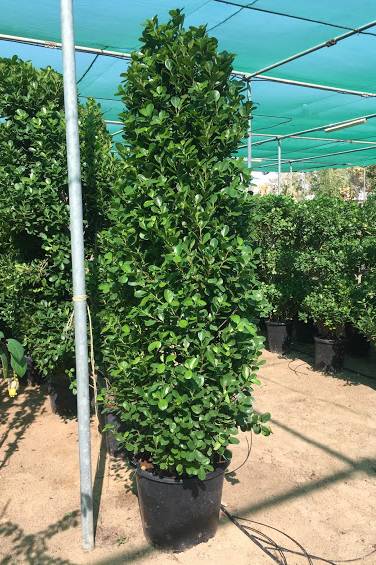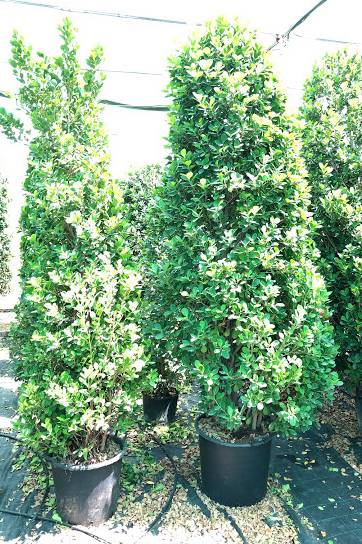Plant Bio
Ficus Panda, also known as Ficus microcarpa 'Panda,' is a cultivar of the Ficus microcarpa species, a member of the fig family (Moraceae). This evergreen tree is admired for its dense foliage and distinctive appearance, making it a popular choice for outdoor landscaping in subtropical and tropical regions. Here's a general description:
Foliage: Ficus Panda is characterized by its glossy, dark green, oval-shaped leaves that are densely packed along the branches, creating a lush canopy. The foliage tends to be more compact and tightly clustered compared to other Ficus microcarpa varieties, giving the tree a distinctive appearance. The leaves may have a slightly waxy texture and are typically 1 to 2 inches (2.5 to 5 centimeters) long.
Trunk and Bark: The trunk of Ficus Panda is often stout and gnarled, with a textured bark that may be grayish-brown to reddish-brown in color. As the tree matures, it may develop aerial roots that hang down from the branches and can eventually reach the ground, providing additional support and stability.
Size: In its natural habitat, Ficus Panda can grow into a medium to large-sized tree, reaching heights of 20 to 50 feet (6 to 15 meters) or more, with a spread of 15 to 35 feet (4.5 to 10.5 meters). However, in cultivation, it can be pruned to maintain a smaller size and shape, making it suitable for various outdoor settings, including gardens, parks, and urban landscapes.
Fruits: Like other Ficus microcarpa varieties, Ficus Panda produces small, round fig-like fruits known as syconia. These fruits are typically green when immature and may turn yellow or orange when ripe, although they are not usually considered ornamental. The fruits are edible but are not widely consumed.
Care Guide for Ficus Panda - Outdoor:
Light: Ficus Panda thrives in full to partial sunlight outdoors, receiving at least 4 to 6 hours of direct sunlight each day. Plant it in a location with ample sunlight exposure, such as a sunny spot in the garden or along the southern or western side of a building. Avoid placing it in deep shade, as this can result in sparse foliage and reduced growth.
Temperature: Ficus Panda prefers warm, subtropical to tropical climates and is suitable for USDA hardiness zones 10 to 11. It requires temperatures above 50°F (10°C) and is sensitive to frost and freezing temperatures, which can damage the foliage and stems. Protect young or newly planted trees from cold drafts and extreme temperature fluctuations.
Soil: Plant Ficus Panda in well-draining, fertile soil with a pH range of 6.0 to 7.5. A loamy or sandy soil enriched with organic matter such as compost or aged manure works well. Ensure that the soil retains moisture while allowing excess water to drain away to prevent waterlogging, which can lead to root rot.
Watering: Keep the soil consistently moist but not waterlogged, especially during the growing season (spring through fall). Water Ficus Panda deeply and thoroughly when the top inch (2.5 centimeters) of soil feels dry to the touch, ensuring that the entire root ball is adequately hydrated. Reduce watering frequency during the winter months when growth slows down.
Mulching: Apply a 2 to 3-inch (5 to 7.5-centimeter) layer of organic mulch, such as shredded bark or compost, around the base of Ficus Panda to conserve soil moisture, suppress weed growth, and regulate soil temperature. Keep the mulch several inches away from the trunk to prevent moisture-related issues and stem rot.
Fertilization: Feed Ficus Panda with a balanced, slow-release fertilizer formulated for trees and shrubs in spring and summer. Follow the manufacturer's instructions for application rates and frequency. Avoid overfertilizing, as it can lead to excessive foliage growth at the expense of overall plant health.
Pruning: Prune Ficus Panda as needed to remove any dead, diseased, or damaged branches and maintain a desirable size and shape. Use sharp, sterilized pruning tools to make clean cuts and minimize the risk of disease transmission. Regular pruning also helps stimulate new growth and rejuvenate the tree over time.
Pest and Disease Control: Monitor Ficus Panda regularly for signs of common pests such as scale insects, mealybugs, aphids, and spider mites. Treat infestations promptly with insecticidal soap, neem oil, or horticultural oil. Ensure good air circulation around the tree and avoid overcrowding to minimize the risk of fungal diseases such as leaf spot or powdery mildew.
Aerial Root Management: In its natural habitat, Ficus Panda may develop aerial roots that hang down from the branches and can eventually reach the ground. While these roots provide additional support and stability for the tree, they may not be desired in all outdoor settings. Monitor the development of aerial roots and prune them as needed to maintain the tree's appearance and prevent overcrowding.
By following these care guidelines, you can cultivate a healthy and attractive Ficus Panda tree in your outdoor landscape, enhancing the beauty of your garden or outdoor space with its dense foliage and distinctive form. Adjust the care routine based on your local climate, soil conditions, and growing preferences to ensure optimal growth and vigor.










